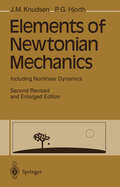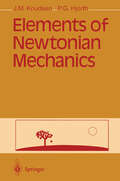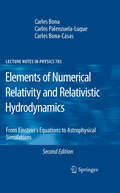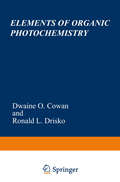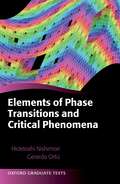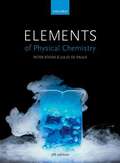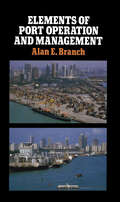- Table View
- List View
Elements of Molecular and Biomolecular Electrochemistry: An Electrochemical Approach to Electron Transfer Chemistry (Baker Lecture Series #13)
by Jean-Michel SavéantThis book is based on the George Fisher Baker Lecture given by Jean-Michel Savéant at Cornell University in Fall 2002. * The first book focusing on molecular electrochemistry * Relates to other fields, including photochemistry and biochemistry * Outlines clearly the connection between concepts, experimental illustrations, proofs and supporting methods * Appendixes to provide rigorous demonstrations to prevent an overload of algebra in the main text * Applications-oriented, focused on analyzing the results obtained rather than the methodology
Elements of Molecular and Biomolecular Electrochemistry: An Electrochemical Approach to Electron Transfer Chemistry (Baker Lecture Ser. #13)
by Jean-Michel Savéant Cyrille CostentinWritten by two of the world's leading authorities in the field of electrochemistry, this book comprehensively addresses workhorse electrochemical reactions that serve as the basis of modern research for alternative energy solutions. Provides an accessible and readable summary on the use of electrochemical techniques and the applications of electrochemical concepts to functional molecular-level systems Includes a new chapter on proton coupled electron transfer, a completely revamped chapter on molecular catalysis of electrochemical reactions, and added sections throughout the book Bridges a gap and strengthens the relationship between electrochemists, molecular and biomolecular chemists—showing a variety of functions that may be obtained by multi-component systems designed using the paradigms of both chemistries
Elements of Molecular and Biomolecular Electrochemistry: An Electrochemical Approach to Electron Transfer Chemistry
by Jean-Michel Savéant Cyrille CostentinWritten by two of the world's leading authorities in the field of electrochemistry, this book comprehensively addresses workhorse electrochemical reactions that serve as the basis of modern research for alternative energy solutions. Provides an accessible and readable summary on the use of electrochemical techniques and the applications of electrochemical concepts to functional molecular-level systems Includes a new chapter on proton coupled electron transfer, a completely revamped chapter on molecular catalysis of electrochemical reactions, and added sections throughout the book Bridges a gap and strengthens the relationship between electrochemists, molecular and biomolecular chemists—showing a variety of functions that may be obtained by multi-component systems designed using the paradigms of both chemistries
Elements of Multivariate Time Series Analysis (Springer Series in Statistics)
by Gregory C. ReinselThe use of methods of time series analysis in the study of multivariate time series has become of increased interest in recent years. Although the methods are rather well developed and understood for univarjate time series analysis, the situation is not so complete for the multivariate case. This book is designed to introduce the basic concepts and methods that are useful in the analysis and modeling of multivariate time series, with illustrations of these basic ideas. The development includes both traditional topics such as autocovariance and auto correlation matrices of stationary processes, properties of vector ARMA models, forecasting ARMA processes, least squares and maximum likelihood estimation techniques for vector AR and ARMA models, and model checking diagnostics for residuals, as well as topics of more recent interest for vector ARMA models such as reduced rank structure, structural indices, scalar component models, canonical correlation analyses for vector time series, multivariate unit-root models and cointegration structure, and state-space models and Kalman filtering techniques and applications. This book concentrates on the time-domain analysis of multivariate time series, and the important subject of spectral analysis is not considered here. For that topic, the reader is referred to the excellent books by Jenkins and Watts (1968), Hannan (1970), Priestley (1981), and others.
The Elements of Murder: A History of Poison
by John EmsleyThis book is about elements that kill. Mercury, arsenic, antimony, lead, and thallium can be lethal, as many a poisoner knew too well. Emsley explores the gruesome history of these elements and those who have succumbed to them in a fascinating narrative that weaves together stories of true crime, enduring historical mysteries, tragic accidents, and the science behind it all. The colourful cast includes ancient alchemists, kings, leaders, a pope, several great musicians, and a motley crew of murderers. Among the intriguing accounts is that of the 17th century poet Sir Thomas Overbury, who survived four attempts to poison him with mercury but died when given the poison in enema form - under whose direction remains uncertain. Here, too, is detailed the celebrated case of Florence Maybrick, convicted of poisoning her violent husband James with arsenic, but widely believed at the time to be innocent. The question of her guilt is still disputed. Threaded through the book alongside the history is the growing understanding of chemistry, and the effects of different chemical substances on the human body. Thousands suffered the ill effects of poisonous vapours from mercury, lead, and arsenic before the dangers were realized. Hatters went mad because of mercury poisoning, and hundreds of young girls working in factories manufacturing wallpaper in the 19th century were poisoned by the arsenic-based green pigments used for the leaves of the popular floral designs. Even in the middle of the 20th century, accidental mercury poisoning caused many deaths in Minamata Bay, while leaded petrol poisoned the whole planet, and arsenic still continues to poison millions is Asia. Through vividly told stories of innocent blunders, industrial accidents, poisoners of various hues - cold, cunning, desperate - and deaths that remain a mystery, Emsley here uncovers the dark side of the Periodic Table.
Elements of Newtonian Mechanics: Including Nonlinear Dynamics
by Jens M. Knudsen Poul G. HjorthIn the second edition, a number of misprints that appeared in the first edition have been corrected. In addition to this, we have made improvements based on the experience gathered in the use of the first English edition of the book in the introductory course in physics at the University of Copenhagen. A chapter introducing nonlinear dynamics has been added. The purpose of this chapter is to provide supplementary reading for the students who are interested in this area of active research, where Newtonian mechanics plays an essential role. The students who wish to dig deeper, should consult texts dedicated to the study of nonlinear dynamical systems and chaos. The literature list at the end of this book contains several references for the topic. The book still contains a one-semester (15 weeks) first university course on Newtonian mechanics. This necessarily introduces some constraints on the choice of topics and the level of mathematical sophistication expected from the reader. If one looks for discussions of technical issues, such as the physics behind various manifestations of friction, or the tensorial nature of the rotation vector, one will look in vain. The book contains what we feel are the essential aspects of Newtonian Mechanics. It is a pleasure again to thank Springer-Verlag and in particular Dr. H. J. KOisch and the staff at the Heidelberg office for helpfulness and professional collaboration.
Elements of Newtonian Mechanics
by Jens M. Knudsen Poul G. HjorthThis book is intended as a textbook for an entry-level university course in Newtonian mechanics for students of physics, astronomy, and the engineering sciences. The material has been used as a first-semester text for first-year undergraduates at the Niels Bohr Institute, which is part of the University of Copenhagen. Our way of presenting Newtonian mechanics is influenced by the writings of the late Max Born. Also, the Feynman Lectures on Physics have been an important source of inspiration. In fact, the idea for the book came when we read Section 16.1 of Volume 1 of the Feynman Lectures. Ideas from the well-known Berkeley Physics Course may also be traced in the text. All of the books quoted in the literature list have, in one way or another, served as a source for our lectures for undergraduates. It is assumed that the students already have a rudimentary knowledge of Newtonian mechanics, say at the high-school level. Some background in vectors and elementary calculus is also required, i.e., the students should know how to add vectors as well as how to differentiate and integrate elementary functions. The Appendix contains the required background for the use of vectors in Newtonian mechanics.
Elements of Newtonian Mechanics: Including Nonlinear Dynamics (Advanced Texts in Physics)
by Jens M. Knudsen Poul G. HjorthIn the third edition a number of minor misprints that appeared in the second edition have have been corrected. Furthermore, 17 new problems have been added, at the end of chapters 6, 8, 9, 11, 12, 13, and 14. The answers to these 17 problems have not been listed in the 'Answers' section at the end of the book. This will permit the problems to be used as hand-in problems or perhaps in mid-term exams. JMK €9 PGH Copenhagen May 2000 Preface to the Second Edition In the second edition, a number of misprints that appeared in the first edition have been corrected. In addition to this, we have made improvements based on the experience gathered in the use of the first English edition of the book in the introductory course in physics at the University of Copenhagen. A chapter introducing nonlinear dynamics has been added. The purpose of this chapter is to provide supplementary reading for the students who are interested in this area of active research, where Newtonian mechanics plays an essential role. The students who wish to dig deeper, should consult texts dedicated to the study of nonlinear dynamical systems and chaos. The literature list at the end of this book contains several references for the topic.
Elements of Noncommutative Geometry: (pdf) (Birkhäuser Advanced Texts Basler Lehrbücher)
by Joseph C. Varilly Hector Figueroa Jose M. Gracia-BondiaElements of Nonequilibrium Statistical Mechanics
by V. BalakrishnanThis book deals with the basic principles and techniques of nonequilibrium statistical mechanics. The importance of this subject is growing rapidly in view of the advances being made, both experimentally and theoretically, in statistical physics, chemical physics, biological physics, complex systems and several other areas. The presentation of topics is quite self-contained, and the choice of topics enables the student to form a coherent picture of the subject. The approach is unique in that classical mechanical formulation takes center stage. The book is of particular interest to advanced undergraduate and graduate students in engineering departments.
Elements of Nonlinear Time Series Analysis and Forecasting (Springer Series in Statistics)
by Jan G. De GooijerThis book provides an overview of the current state-of-the-art of nonlinear time series analysis, richly illustrated with examples, pseudocode algorithms and real-world applications. Avoiding a “theorem-proof” format, it shows concrete applications on a variety of empirical time series. The book can be used in graduate courses in nonlinear time series and at the same time also includes interesting material for more advanced readers. Though it is largely self-contained, readers require an understanding of basic linear time series concepts, Markov chains and Monte Carlo simulation methods.The book covers time-domain and frequency-domain methods for the analysis of both univariate and multivariate (vector) time series. It makes a clear distinction between parametric models on the one hand, and semi- and nonparametric models/methods on the other. This offers the reader the option of concentrating exclusively on one of these nonlinear time series analysis methods.To make the book as user friendly as possible, major supporting concepts and specialized tables are appended at the end of every chapter. In addition, each chapter concludes with a set of key terms and concepts, as well as a summary of the main findings. Lastly, the book offers numerous theoretical and empirical exercises, with answers provided by the author in an extensive solutions manual.
Elements Of Nuclei: Many-body Physics With The Strong Interaction
by Philip J. SiemensIn the present volume, Phillip J. Siemens, who has been a seminal contributor to our understanding of the nucleus as a many-body system, and his able collabourator, Aksel S. Jensen, introduce graduate students and colleagues in other fields to the basic concepts of nuclear physics in a way which connects clearly the methods of nuclear physics with those of condensed matter, atomic, and particle physics. Their book thus provides a lucid introduction to the key facts and concepts of nuclei, including many of the most recent developments, while emphasizing the similarities and the differences between the behaviour of nuclei, atoms, elementary particles, and condensed matter, It should thus prove useful, not only as a text for an introductory graduate course in nuclear physics, but as a reference book for all scientists interested in a unified picture of our understanding of physical phenomena associated with many-body systems.
Elements Of Nuclei: Many-body Physics With The Strong Interaction
by Philip J. SiemensIn the present volume, Phillip J. Siemens, who has been a seminal contributor to our understanding of the nucleus as a many-body system, and his able collabourator, Aksel S. Jensen, introduce graduate students and colleagues in other fields to the basic concepts of nuclear physics in a way which connects clearly the methods of nuclear physics with those of condensed matter, atomic, and particle physics. Their book thus provides a lucid introduction to the key facts and concepts of nuclei, including many of the most recent developments, while emphasizing the similarities and the differences between the behaviour of nuclei, atoms, elementary particles, and condensed matter, It should thus prove useful, not only as a text for an introductory graduate course in nuclear physics, but as a reference book for all scientists interested in a unified picture of our understanding of physical phenomena associated with many-body systems.
Elements of Numerical Relativity and Relativistic Hydrodynamics: From Einstein' s Equations to Astrophysical Simulations (Lecture Notes in Physics #783)
by Carles Bona Carlos Palenzuela-Luque Carles Bona-CasasMany large-scale projects for detecting gravitational radiation are currently being developed, all with the aim of opening a new window onto the observable Universe. As a result, numerical relativity has recently become a major field of research, and Elements of Numerical Relativity and Relativistic Hydrodynamics is a valuable primer for both graduate students and non-specialist researchers wishing to enter the field. A revised and significantly enlarged edition of LNP 673 Elements of Numerical Relativity, this book starts with the most basic insights and aspects of numerical relativity before it develops coherent guidelines for the reliable and convenient selection of each of the following key aspects: evolution formalism; gauge, initial, and boundary conditions; and various numerical algorithms. And in addition to many revisions, it includes new, convenient damping terms for numerical implementations, a presentation of the recently-developed harmonic formalism, and an extensive, new chapter on matter space-times, containing a thorough introduction to relativistic hydrodynamics. While proper reference is given to advanced applications requiring large computational resources, most tests and applications in this book can be performed on a standard PC.
Elements of Optimization: With Applications in Economics and Business (Heidelberg Science Library)
by Delia KooThis book attempts to present the concepts which underlie the various optimization procedures which are commonly used. It is written primarily for those scientists such as economists, operations researchers, and en gineers whose main tools of analysis involve optimization techniques and who possess a (not very sharp) knowledge of one or one-and-a-half year's calculus through partial differentiation and Taylor's theorem and some acquaintance with elementary vector and matrix terminology. Such a scientist is frequently confronted with expressions such as Lagrange multi pliers, first-and second-order conditions, linear programming and activity analysis, duality, the Kuhn-Tucker conditions, and, more recently, dy namic programming and optimal control. He or she uses or needs to use these optimization techniques, and would like to feel more comfortable with them through better understanding of their underlying mathematical concepts, but has no immediate use for a formal theorem-proof treatment which quickly abstracts to a general case of n variables and uses a style and terminology that are discouraging to people who are not mathematics majors. The emphasis of this book is on clarity and plausibility. Through examples which are worked out step by step in detail, I hope to illustrate some tools which will be useful to scientists when they apply optimization techniques to their problems. Most of the chapters may be read independently of each other-with the exception of Chapter 6, which depends on Chapter 5. For instance, the reader will find little or no difficulty in reading Chapter 8 without having read the previous chapters.
Elements of Organic Photochemistry
by D. CowanIn the past fifteen years organic photochemistry has undergone a greater change and has stimulated more interest than probably any other area of organic chemistry. What has resulted is a population explosion, that is, an ever-increasing number of organic chemists are publishing important and exciting research papers in this area. Professor Bryce-Smith in the introduc tion to a recent volume of the Specialist Periodical Report (Photochemistry, Volume 6), which reviews the photochemical literature in yearly intervals, states that "the flood of photochemical literature is showing some signs of abatement from the high levels of two or three years ago .... " However, Volume 6 of that periodical contains 764 pages of excellent but very concise reviews. We expect the development of the mechanistic aspects of organic photo chemistry to continue at the present pace as new methods are developed to probe in increasing detail and shorter time scales the photochemical dynamics of both old and new photoreactions. Since photochemistry is no longer the sole domain of the specialist, it is relatively safe to predict a dramatic increase in the near future of the synthetic and industrial uses of organic photo chemistry .
Elements of Phase Transitions and Critical Phenomena (Oxford Graduate Texts)
by Hidetoshi Nishimori Gerardo OrtizAs an introductory account of the theory of phase transitions and critical phenomena, this book reflects lectures given by the authors to graduate students at their departments and is thus classroom-tested to help beginners enter the field. Most parts are written as self-contained units and every new concept or calculation is explained in detail without assuming prior knowledge of the subject. The book significantly enhances and revises a Japanese version which is a bestseller in the Japenese market and is considered a standard textbook in the field. It contains new pedagogical presentations of field theory methods, including a chapter on conformal field theory, and various modern developments hard to find in a single textbook on phase transitions. Exercises are presented as the topics develop, with solutions found at the end of the book, making the usefil for self-teaching, as well as for classroom learning.
Elements of Physical Hydrology
by George M. Hornberger Patricia L. Wiberg Jeffrey P. Raffensperger Paolo D'OdoricoAmong the many diverse aspects of environmental science, none is more critical to the future of society and nature than water. Understanding the role of water on Earth and making good decisions regarding water conservation and hydrological hazards depends on learning the fundamentals of physical hydrology. This textbook, now in an expanded second edition, provides the clearest opportunity for students to absorb those fundamentals. Written at an introductory level, Elements of Physical Hydrology covers virtually every aspect of this subject, including:• The hydrological cycle• Water budgets at catchment to global scales • Spatial and temporal aspects of precipitation• Evapotranspiration• Fluid dynamics and the Bernoulli equation• Laminar and turbulent flows• Open channel flow • Flood movement through reservoirs and channels • Flood frequency analysis• Groundwater flow• Aquifer characterization• Land subsidence• Soil moisture dynamics• Flow in the unsaturated zone• Hydrologic controls on vegetation • Biotic controls on hydrological processes• Runoff generation from surface and subsurface sources• Catchment models• The water-food-energy nexus• The globalization of water• Impacts of changing climateLayering one topic upon the next, Elements of Physical Hydrology succeeds in moving from simple, easy-to-grasp explanations through equations and models in a manner that will leave students new to the topic eager to apply their knowledge. Professionals in related disciplines will also find this book ideal for self-study. Thoughtfully illustrated, carefully written, and covering a broad spectrum of topics, this classic text clarifies a subject that is often misunderstood and oversimplified.
Elements of Physics
by M. WellnerTo the Instructor We are seeing an increased need for a one-year While the language of calculus is indispensable survey of physics, at the calculus level, and with here, its manipulative power will, with some regret, the inclusion of some modern physics. A growing be left pretty much unexploited; calculus-centered number of students-in engineering as well as in exercises, seductive though they are, would not the sciences-must take early technical courses that help us accomplish our mission. demand a reasonable familiarity with physics as a Suggested scheduling. How much material whole. should be covered in one term? Some possible The present book is a response to that need. The apportionments of the 28 chapters (24 without the author is well aware that introductory physics modern physics) are indicated in the table below. cannot be compressed or pruned ad infinitum; nevertheless, the one-year goal may yet be reachable. With modern Without modern A slim volume does not seem to be the answer. physics physics Rather than compressing or pruning, I have tried to work towards a smoother exposition. To that 2 terms 14+ 14 12+ 12 end a variety of devices-not necessarily bulk 3 terms 9+ 10+9 9+8+7 saving-have been enlisted: a liberal use of line drawings; a modest number of chapters, but each Enough problems are provided for three full fairly broad, in the hope of improving the con semesters, if desirable.
Elements of Plasma Technology (SpringerBriefs in Applied Sciences and Technology)
by Chiow San Wong Rattachat MongkolnavinThis book presents some fundamental aspects of plasma technology that are important for beginners interested to start research in the area of plasma technology. These include the properties of plasma, methods of plasma generation and basic plasma diagnostic techniques. It also discusses several low cost plasma devices, including pulsed plasma sources such as plasma focus, pulsed capillary discharge, vacuum spark and exploding wire; as well as low temperature plasmas such as glow discharge and dielectric barrier discharge which the authors believe may have potential applications in industry. The treatments are experimental rather than theoretical, although some theoretical background is provided where appropriate. The principles of operation of these devices are also reviewed and discussed.
Elements of Port Operation and Management
by Alan BranchSince the publication of my books Elements of Shipping and more recently Economics of Shipping Practice and Management, both selling in over 130 countries, I have received numerous requests both from home and abroad for a companion volume on seaports. This book has been written to provide a practical, overall under standing of the elements of port operation and management of a competitive,~profitable port authority. It reflects the author's many years of experience in port and ship management, international trade and education. It deals in simple language with the role and function of seaports in a trading pattern, port investment criteria, port tariffs, free ports and free trade zones, port traffic control, budgetary control and marketing, port management structure and dock labour, computerization, cargo-handling equipment, the eco nomics of port design, the role of port cargo-handling organiza tions, the economics of international trade, finance of international trade, and many other aspects of this extensive subject. The import ance of complete professionalism in all areas of port practice as a means of providing the viable, high quality service required to sustain and expand international trade cannot be overemphasized. This book will help towards establishing that professionalism. The material assembled here is intended not only for students preparing for seaport examinations, but also for persons employed in port authorities. In short, it is an aide-memoire to those engaged in the industry throughout the world and may be regarded as 'the porr executive's handbook'.
Elements of Psychophysical Theory (Oxford Psychology Series)
by Jean-Claude FalmagneThis book presents the basic concepts of classical psychophysics, derived from Gustav Fechner, as seen from the perspective of modern measurement theory. The theoretical discussion is elucidated with examples and numerous problems, and solutions to one-quarter of the problems are provided in the text.
Elements of Quantum Chemistry
by Rudolf Zahradník Rudolf PolákThe post-war generation of chemists learned to handle a blow pipe at the university as thoroughly as modern chemistry students learn to write computer programmes. Even after World War II the rule of three was considered to be sufficient mathematical knowledge for chemists and the short course of "higher mathematics" at technical universities was the test most feared by chemistry students. However, even then some en visaged the theoretical derivation of information on the properties of molecules from knowledge of the bonding of the component atoms. During the last quarter of this century, amazing changes have occurred in chemistry, some of them almost incredible. Dirac's famous clairvoyant statement* has been partially realized. Incorporation of quantum mechanics into chemistry encountered numerous difficulties. After all, the reserve of experimental chemists is not surprising. For decades the hydrogen and helium atoms and the hydrogen molecule belonged among the systems most frequently investigated by theoreti cians. Later these systems were supplemented by ethylene and benzene. The authors of this book can therefore recall with understanding the words of the late Professor Lukes: "Well, when they succeed in computing a molecule of some alkaloid by those methods of yours ... ". Unfortunately, the calculations on calycanin were not completed before his death. Now there is no need to convince even the members of the older generation of the usefulness of quantum chemistry for chemists. Even the most conservative were convinced after the introduction of the W ood ward-Hoffmann rules.




